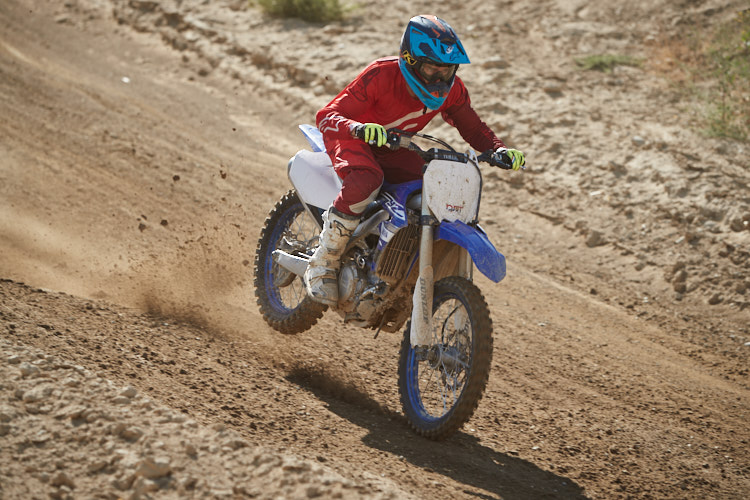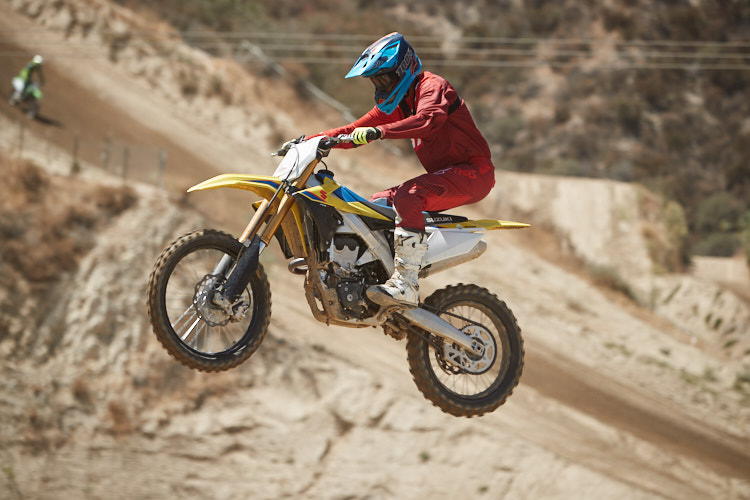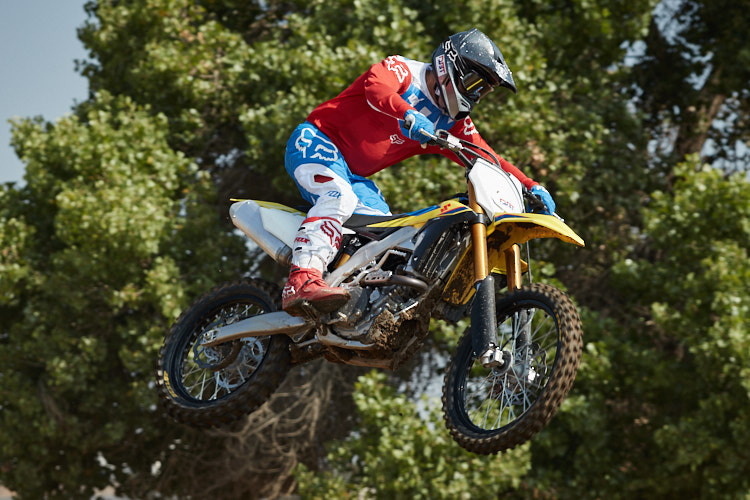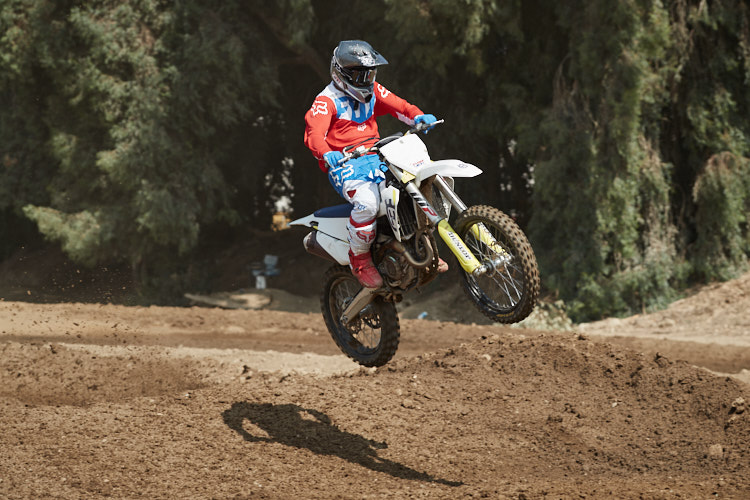Jimmy Lewis

Age: 50
Ability: Senior Expert
Years Riding: 40
Height: 5’10”
Weight: 192 lb./ 213 with gear.
Personal Rides: 2005 Yamaha YZ125, 2017 KTM 1090R
I love riding all the new 2019 450cc MX bikes for a comparison. I hate being called on to pick a winner. I can tell you what I like and why, or even easier, what I didn’t like and why. But telling you which is the best bike is about as valid as you telling me you don’t approve of my opinion.
It was tougher than I thought to pick the Yamaha YZ450F as the best single bike for me. Because there were times the Honda and Kawasaki really shined. Yet as it is clear in this comparison, the Yamaha’s suspension is really good. Not just for me but seemingly everyone. It has that plushness and ability to handle the small bumps while still providing great control of the entire travel of the shock and fork with bottoming resistance as good as anything out there. Putting the suspension aside, the YZ450F motor has a potent brew of power everywhere and it is the most responsive feeling in the class to me. It was most connected from my wrist to the rear wheel and the easiest to make a quick change for personal preference with the Yamaha Power Tuner App. However, it wasn’t much use for me this year. Stock was excellent. Aside from dropping a tooth on the rear sprocket at Glen Helen, I did not touch a clicker or feel a different map worked any better than the way the bike rolls off the showroom floor. Set the sag at 105mm and race. The gearing change really worked since I was between gears all over the hilly Glen Helen National track and none of the maps I tried changed this. Being between gears had me shifting at the wrong parts exiting the turns and also made in-turn throttle too touchy or not responsive enough. It must be told that I typically ride a gear higher than most and don’t like shifting as much as most riders do. It is the little things like this that were making and breaking the bikes. Some characteristics much easier to cure, like this gearing change.
I can see some larger and heavier riders not getting along as well with the YZ but moving/changing the bars and a taller seat could remedy this. And anything aside from the bike seeming a little wider at the front or not having enough power (really?) could be altered with a mapping change. The bike handles in a very consistent and neutral way with plenty of stability. The clutch, shifting, brakes all get the job done without standing out.

Next was a tie between the Honda and the Kawasaki for me. I’d lean towards the Honda for brute power and a very stout and confident ride. The Honda wants to be ridden hard, all the time and it’s power commands a rider’s attention if you are going to go fast. There isn’t the initial plushness of some of the other bikes, but there is great bottoming resistance. Because of the CRF’s setup it fared better with larger and heavier riders. All of the little improvements to this bike really help it and it’s a bike that wins motos and overalls (categories in this comparison) but not the championship. The downsides for me were a stiff clutch pull and switching between maps is not an “on the fly” thing. Spending a little time with the HRC tuning tool can easily fix the engine character and the suspension would only take more seat time to get use to thus making the more plush bikes feel too soft. I set the Honda to 106-108mm sag and did not want to mess with the clickers since any softer here affected the handling more than it improved the feel.
The KX falls into the same category as the CRF with some real standout features. It is the most changed bike from it’s previous version and for most riders this is a better starting point. I really liked the older bike, especially the motor, yet this one is a little more polar to me. The brakes are the strongest in the field but do not have the modulation until you get use to them. I found myself liking parts of two different maps via the supplied coupliers. We were able to use the KX tuning tool to make a custom map but it would still need further tuning to perfect the character for me. The suspension was excellent 90% of the time but there were times when the shock or fork would go through the stroke a little too fast for no real reason. The bike also needs to have the slightly stiffer front spring setup (one stiffer .52 spring in one of the forks) to get rid of the yaw in the chassis. It is so close to the Yamaha in so many ways, and with just some small tweaks and time getting comfortable on this bike, it would be right at the top. I ran 106mm of sag and found the rougher the track, the better the bike worked compared to others. Getting the handling just right involved tuning with the high-speed compression +/- ¼-turn.
Both the Honda and Kawasaki handle great and are not slow–if anything too fast. But with the Honda being less compliant and the KX being a little picky takes them off the top of the list for me. But it would firstly take time getting use to each of them more, then some very particular and easy tuning to get them just right.
Next comes the KTM. It is also a bike I really liked to ride but it’s overall character is not for me. (Coming from a guy who has more KTMs than hairs on his head.) It is for someone who wants to race more aggressively and rev the bike more than I prefer too. And the longer rear brake pedal hid from me more times that I can recount. The very first thing I’d do to the KTM (and Husky) would be to switch back to the 2016 brake pedal!
The KTM power builds in more of an exponential way than a linear fashion. It has great throttle response, especially in the higher rev range and it always stays light feeling. The handling is aggressive and quick but it never loses that planted to the ground feeling. I love the light front end sensation and the air fork is excellent. The shock compliments the feeling but they are picky about setup. Between the KTM and the Husky if you were a little off in ride height or in clicker setup, the rest of the bike really didn’t cooperate. Simply put, for me they were a little too picky. A lot of this is because at my weight I’m just above where the stock shock spring can handle. I would have tried a stiffer spring if I gelled more with the engine character because the KTM was that close to being on the top tier.
The KTM, along with the Yamaha, would be my first recommendation for riders moving up from a 250F and especially if you are more on the intermediate or expert side of the spectrum. The KTM still has the best brakes in power and especially in feel. Additionally, you can switch between maps and add traction control while in the air with a push of the button. I never used the Traction Control setting since I never felt the need but some of our riders really liked it.

The Suzuki does not have an electric start. So right away I’m going to show you how sometimes it is the little things that can sway things. A big one in this case for me. The RM-Z has a stiff chassis combined with a suspension setup that is a little too stiff initially–then moves a little too freely in the mid-stroke so the bike is a little busy most of the time, especially if the track is choppy. I’m not sold on the different technology used on the RM-Z shock, called BRFC, but it isn’t an issue unless you get really picky. I like to use the high-speed compression to adjust the ride height feel of the bike and it is absent on the Suzuki making me use the rebound to try and get the same feel.
The RM-Z carves a turn (usually a smooth one) like it is nobody’s business and has a thin feel and acts much lighter than the scale says. Frankly, the motor is excellent and one of the easiest to ride and put down fast laps. It may not feel like a power king, but I never got pulled on it — even on the uphills at Glen Helen. And with jumps out of tight turns, where you need power, the RM-Z never lacked, in fact it hooked up easier and threw me farther than the Honda, KTM or Husky. On the top end where the RMZ may feel lacking to other bikes, there is rarely the traction to harness that level of power. I did not feel the Suzuki was ever lacking power. So if you ride on a mostly smooth track you’ll never encounter the Suzuki’s issues. If you do not mind kick starting, do not overlook the Suzuki. And it is the least expensive bike by $300-$500 and that is before rebates and the like. In fact this bike is a shock spring away from the 2018 version which can be had for a lot less.
The Husky is not last, it is just the bike that had the most things that didn’t jell with Jimmy. Likely since it was so close and similar to the KTM these things stood out more than normal. There was no question for me on why I’d choose the Orange bike over the White bike but maybe you are the other way around? I know some of our test riders definitely were. The Husky has a “softer” feel everywhere. The power has a little less throttle response, the bite of the clutch is a little different (quicker bite, not as easy to modulate slipping) and compliments this feel. The chassis has a little more give in it and you feel the wheels less. However, the bikes do exactly the same thing in the handling and suspension departments. If you like to rev the engine a little more before you snap the clutch, you will like the Husky better than the KTM. I like to let the clutch out and use the throttle to control the bike so the responsiveness of the KTM works better for my style. But some bikes also work better for my style than the KTM, so this Husky does not fit me like a glove. Like the KTM I ran the Husky with 10.5 bar for air and set the shock with 105mm of sag and slowed the rebound of the shock 2 clicks. Final tuning was with ¼-turn of high-speed compression to get the balance right.

With any of these bikes I could do a few modifications (aside from adding an E-start to the Suzuki) and get them to be at the top of the list. If grading them on a scale to 100, none would get lower than a 92% when I hand out grades. And I could make a case for any of the bikes based on each’s merritts. Things like contingency, your dealer, or even wanting to change it up from your current ride could sway a pick from one to another.
Support DBT by searching and shopping through links below:

